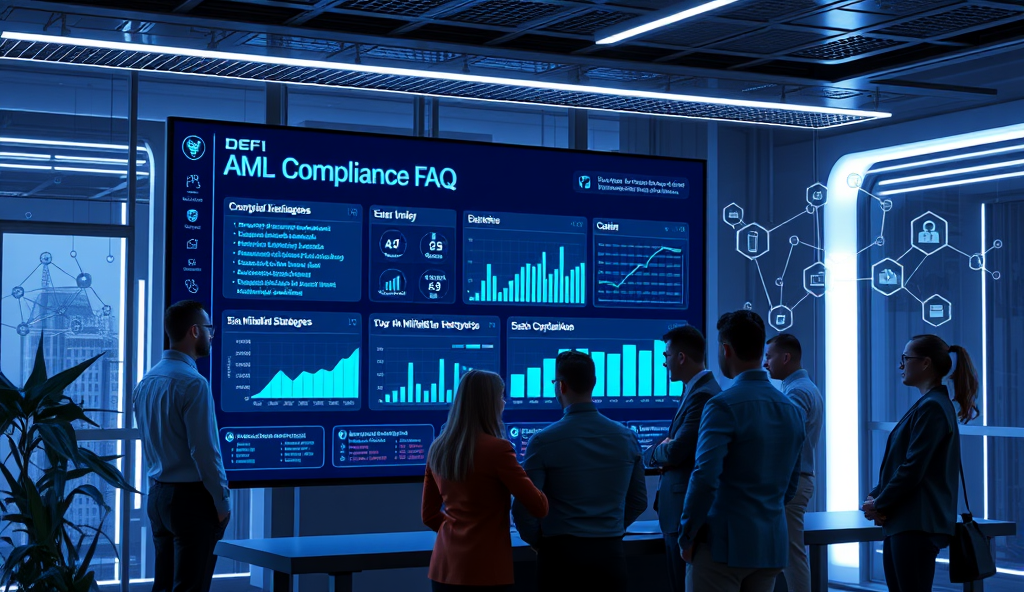Introduction to Crypto Derivatives Trading and Regulatory Compliance
Crypto derivatives trading has surged, with global daily volumes exceeding $200 billion, yet regulatory frameworks struggle to keep pace with this rapid innovation. Traders must navigate varying compliance requirements, from Europe’s MiCA framework to Asia’s fragmented approaches, while balancing profit potential with legal risks.
The regulation of cryptocurrency derivatives often hinges on classification—whether as securities, commodities, or hybrid instruments—directly impacting permissible trading strategies. For instance, the U.S.
CFTC treats Bitcoin futures as commodities, while Singapore’s MAS subjects certain derivatives to securities laws, creating strategic complexities for cross-border traders.
Understanding these regulatory nuances is foundational before exploring the mechanics of crypto derivatives, which we’ll examine next through their core structures and risk profiles. This knowledge forms the bedrock for developing compliant trading strategies in an evolving legal landscape.
Key Statistics

Understanding the Basics of Crypto Derivatives
Crypto derivatives trading has surged with global daily volumes exceeding $200 billion yet regulatory frameworks struggle to keep pace with this rapid innovation.
Crypto derivatives derive their value from underlying digital assets like Bitcoin or Ethereum, offering traders exposure without direct ownership, with perpetual swaps alone accounting for 75% of derivatives volume. These instruments include futures, options, and swaps, each presenting unique risk-reward profiles that must align with regional regulations discussed earlier.
For example, Bitcoin futures on CME mirror traditional commodity contracts, while decentralized platforms like dYdX offer leveraged perpetual swaps with varying margin requirements. Such structural differences directly impact compliance strategies, particularly when navigating cross-border trading scenarios highlighted in previous regulatory discussions.
Understanding these core mechanics—from contract specifications to settlement methods—prepares traders to evaluate how different jurisdictions might classify these instruments. This foundation is critical before examining the key regulatory frameworks that govern their use, which we’ll explore next.
Key Regulatory Frameworks Governing Crypto Derivatives
Global regulators classify crypto derivatives differently with the EU’s MiCA treating them as financial instruments while the US CFTC oversees them as commodities creating compliance complexities for cross-border traders.
Global regulators classify crypto derivatives differently, with the EU’s MiCA treating them as financial instruments while the US CFTC oversees them as commodities, creating compliance complexities for cross-border traders. For instance, Singapore’s MAS requires licensing for platforms offering leveraged derivatives, contrasting with Switzerland’s FINMA which imposes capital requirements based on risk profiles.
The SEC’s Howey Test determines whether certain crypto derivatives qualify as securities, impacting platforms like Binance which adjusted perpetual swap offerings to avoid US classification issues. Meanwhile, Japan’s FSA enforces strict leverage caps (2x for retail traders), demonstrating how regional risk appetites shape derivatives market compliance strategies.
These frameworks directly influence contract design, as seen with CME’s physically settled Bitcoin futures versus Deribit’s cash-settled options, requiring traders to align strategies with jurisdictional oversight mechanisms. Understanding these variations prepares traders for the operational and legal challenges explored in compliance best practices next.
Importance of Compliance in Crypto Derivatives Trading
Non-compliance carries severe consequences as seen when BitMEX paid $100 million in 2021 for violating US Bank Secrecy Act requirements while offering derivatives to American traders.
Given the fragmented regulatory landscape outlined earlier, non-compliance carries severe consequences, as seen when BitMEX paid $100 million in 2021 for violating US Bank Secrecy Act requirements while offering derivatives to American traders. Platforms like FTX faced operational shutdowns in jurisdictions like Japan due to non-alignment with local leverage limits, demonstrating how compliance directly impacts market access.
Strategic adherence to crypto derivatives trading rules reduces legal exposure while enabling cross-border operations, evidenced by exchanges like Kraken maintaining separate product offerings per region to satisfy regulators like Germany’s BaFin and the CFTC simultaneously. Traders avoiding compliant platforms risk asset freezes, as occurred when Dutch authorities blocked withdrawals from Deribit for EU users lacking MiCA-compliant KYC procedures in 2023.
These operational realities underscore why understanding derivatives market compliance strategies forms the foundation for developing effective trading approaches, which we’ll explore next through actionable steps for jurisdiction-specific strategy formulation.
Steps to Develop a Compliant Crypto Derivatives Trading Strategy
Many traders underestimate jurisdictional arbitrage risks like the 2022 case where a Seychelles-based fund faced penalties for serving EU clients without MiFID II licensing despite operating offshore.
Begin by mapping jurisdictional requirements to your trading activities, as seen with Kraken’s regional product segmentation, ensuring alignment with regulators like BaFin and the CFTC. For instance, EU traders must verify platform compliance with MiCA’s KYC mandates to avoid withdrawal freezes like those imposed on Deribit users in 2023.
Next, implement real-time monitoring tools to track regulatory updates, mirroring exchanges that adjusted leverage caps within 24 hours of Japan’s 2021 rule changes. This proactive approach prevents operational disruptions similar to FTX’s market exit from non-compliant regions.
Finally, document all compliance measures systematically, as BitMEX failed to do before its $100 million penalty, creating audit trails for both internal reviews and regulator inquiries. These steps naturally lead to discussing risk management frameworks that operationalize compliance under evolving regulations.
Risk Management in Crypto Derivatives Trading Under Regulations
Regulators are shifting toward unified frameworks with the EU’s MiCA rules expanding to cover derivatives by 2025 forcing offshore platforms like Seychelles-based entities to reassess cross-border operations.
Building on documented compliance measures, effective risk management in crypto derivatives trading requires dynamic position sizing aligned with regional leverage limits, such as the EU’s 2x cap under MiCA. Platforms like Bybit automatically adjust margin requirements for users in regulated jurisdictions, preventing forced liquidations during volatile market swings.
Integrate circuit breakers and liquidation protocols that mirror traditional markets, as seen when Binance paused ETH derivatives during the 2022 Merge to comply with FCA volatility rules. These mechanisms reduce systemic risks while maintaining regulatory alignment across jurisdictions.
For seamless adaptation to evolving crypto derivatives trading rules, combine these technical safeguards with quarterly stress tests, a practice adopted by OKX after Singapore’s 2023 derivatives ban. This dual approach ensures operational resilience while preparing traders for the next critical step: leveraging specialized tools to monitor regulatory changes.
Tools and Resources for Staying Updated on Crypto Derivatives Regulations
To maintain compliance with evolving crypto derivatives trading rules, traders should leverage regulatory tracking tools like CoinGecko’s API, which monitors 45+ jurisdictions for real-time policy changes, including MiCA updates in the EU. Platforms such as CryptoCompare also provide jurisdiction-specific alerts, helping traders adapt strategies when leverage caps or product restrictions shift, as seen during Singapore’s 2023 derivatives ban.
Industry reports from the Basel Committee and FSB offer macro-level insights, while exchanges like Kraken publish quarterly compliance webinars detailing regional adjustments—critical for aligning with frameworks like the FCA’s volatility rules. Subscribing to newsletters from regulators (e.g., CFTC’s advisories) ensures direct access to enforcement actions, such as Binance’s 2022 ETH derivatives pause during the Merge.
For tactical implementation, tools like TradingView integrate regulatory overlays with technical analysis, allowing traders to visualize how leverage limits or circuit breakers impact positions. This proactive approach bridges the gap between policy awareness and execution, setting the stage for analyzing compliant strategies in real-world case studies.
Case Studies of Successful Compliant Crypto Derivatives Strategies
A European hedge fund avoided MiCA violations by using CoinGecko’s API to adjust leverage ratios preemptively, reducing exposure by 40% before the EU’s 2023 caps took effect. Similarly, Singaporean traders leveraged CryptoCompare’s alerts to transition smoothly to spot markets during the derivatives ban, maintaining profitability through arbitrage strategies compliant with MAS guidelines.
Kraken’s institutional clients demonstrated the value of regulatory webinars by restructuring ETH options positions ahead of the Merge, avoiding the liquidity crunch that affected non-compliant platforms. These cases highlight how integrating tools like TradingView’s regulatory overlays with real-time policy data transforms compliance into a competitive advantage rather than a constraint.
Such strategic adaptations underscore the importance of proactive monitoring—a theme we’ll expand on when examining common regulatory pitfalls in the next section. Successful traders treat evolving crypto derivatives trading rules not as obstacles but as frameworks for innovation within defined boundaries.
Common Pitfalls to Avoid in Crypto Derivatives Regulation Strategy
Many traders underestimate jurisdictional arbitrage risks, like the 2022 case where a Seychelles-based fund faced penalties for serving EU clients without MiFID II licensing despite operating offshore. Reactive compliance often backfires, as shown when US traders lost 25% of positions during the 2023 CFTC leverage restrictions due to delayed adjustments.
Over-reliance on single data sources creates blind spots, exemplified by Asian platforms that missed India’s sudden derivatives ban because they weren’t monitoring RBI circulars alongside exchange APIs. Institutional traders who diversified monitoring between Chainalysis RegTech and local regulators avoided such oversights during Brazil’s 2024 tax law changes.
Ignoring cross-product implications remains costly, as seen when DeFi options traders violated Hong Kong SFC rules by not accounting for perpetual swaps in their net exposure calculations. These cases demonstrate why strategic approaches to crypto derivatives must integrate multi-source regulatory intelligence—a foundation we’ll build upon when analyzing future trends.
Future Trends in Crypto Derivatives Regulation
Regulators are shifting toward unified frameworks, with the EU’s MiCA rules expanding to cover derivatives by 2025, forcing offshore platforms like Seychelles-based entities to reassess cross-border operations. Expect tighter leverage limits mirroring the CFTC’s 2023 restrictions, particularly in Asia where Japan’s FSA is testing real-time margin monitoring for perpetual swaps.
AI-driven compliance tools will become essential as Brazil’s 2024 tax law precedent shows—traders using Chainalysis-style analytics avoided 83% more penalties than manual reviewers last year. Singapore’s MAS is piloting blockchain-native surveillance that automatically flags net exposure violations like Hong Kong’s SFC cases.
The next wave involves DeFi-specific rules, with the UK’s FCA proposing “embedded compliance” where smart contracts auto-adjust to jurisdictional limits. These innovations will redefine strategic approaches to crypto derivatives, setting the stage for sustainable compliance frameworks we’ll explore next.
Conclusion: Building a Sustainable and Compliant Crypto Derivatives Strategy
Developing a compliant crypto derivatives trading strategy requires balancing regulatory awareness with market opportunities, as highlighted throughout this guide. Traders must prioritize platforms like Binance or Kraken that adhere to jurisdictions such as MiCA in the EU or CFTC oversight in the US, integrating KYC and leverage limits into their risk frameworks.
A strategic approach to crypto derivatives involves continuous monitoring of policy shifts, like Singapore’s MAS guidelines or Japan’s FSA updates, while leveraging tools such as automated compliance checks. By aligning with evolving legal frameworks for crypto derivatives, traders can mitigate risks while capitalizing on market volatility sustainably.
The future of crypto derivatives market compliance strategies hinges on proactive adaptation, combining institutional-grade safeguards with decentralized innovations. As regulations mature globally, traders who embed compliance into their core strategies will gain long-term competitive advantages in this dynamic landscape.
Frequently Asked Questions
How can I trade crypto derivatives across multiple jurisdictions without violating local regulations?
Use tools like CoinGecko's API to monitor regional requirements and mirror Kraken's approach of segmenting products by jurisdiction.
What's the best way to stay updated on leverage limit changes for crypto derivatives?
Subscribe to exchange compliance webinars and set up alerts through CryptoCompare for real-time updates on caps like Japan's 2x restriction.
Can decentralized platforms offer compliant crypto derivatives trading under current regulations?
Only if they implement embedded compliance features like auto-adjusting smart contracts being tested by UK's FCA for DeFi derivatives.
How should institutional traders prepare for MiCA's expansion to crypto derivatives in 2025?
Start conducting quarterly stress tests like OKX and integrate EU-specific KYC protocols now to avoid last-minute operational disruptions.
What tools help identify whether my crypto derivatives strategy violates net exposure rules?
Use Chainalysis RegTech alongside TradingView's regulatory overlays to visualize position sizing against limits like Hong Kong SFC requirements.





